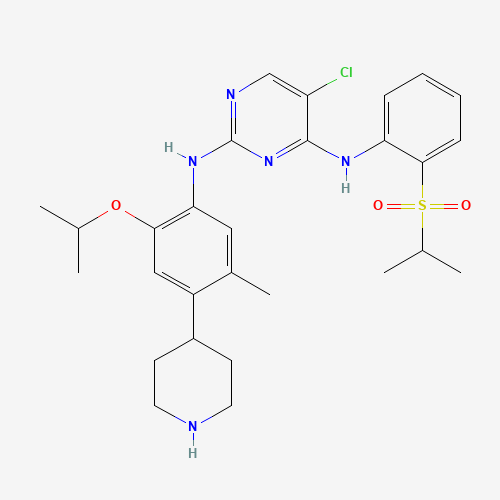| Pharmaceutical Information |
| Drug Name |
Ceritinib |
| Drug ID |
BADD_D00414 |
| Description |
Ceritinib is used for the treatment of adults with anaplastic lymphoma kinase (ALK)-positive metastatic non-small cell lung cancer (NSCLC) following failure (secondary to resistance or intolerance) of prior crizotinib therapy. About 4% of patients with NSCLC have a chromosomal rearrangement that generates a fusion gene between EML4 (echinoderm microtubule-associated protein-like 4) and ALK (anaplastic lymphoma kinase), which results in constitutive kinase activity that contributes to carcinogenesis and seems to drive the malignant phenotype. Ceritinib exerts its therapeutic effect by inhibiting autophosphorylation of ALK, ALK-mediated phosphorylation of the downstream signaling protein STAT3, and proliferation of ALK-dependent cancer cells. Following treatment with crizotinib (a first-generation ALK inhibitor), most tumours develop drug resistance due to mutations in key "gatekeeper" residues of the enzyme. This occurrence led to development of novel second-generation ALK inhibitors such as ceritinib to overcome crizotinib resistance. The FDA approved ceritinib in April 2014 due to a surprisingly high response rate (56%) towards crizotinib-resistant tumours and has designated it with orphan drug status. |
| Indications and Usage |
Ceritinib is a kinase inhibitor indicated for the treatment of patients with anaplastic lymphoma kinase (ALK)-positive metastatic non-small cell lung cancer (NSCLC) who have progressed on or are intolerant to crizotinib. This indication is approved under accelerated approval based on tumor response rate and duration of response. An improvement in survival or disease-related symptoms has not been established. Continued approval for this indication may be contingent upon verification and description of clinical benefit in confirmatory trials. |
| Marketing Status |
approved |
| ATC Code |
L01ED02 |
| DrugBank ID |
DB09063
|
| KEGG ID |
D10551
|
| MeSH ID |
C586847
|
| PubChem ID |
57379345
|
| TTD Drug ID |
D04LVK
|
| NDC Product Code |
0078-0694; 54893-0072 |
| UNII |
K418KG2GET
|
| Synonyms |
ceritinib | 5-chloro-N2-(2-isopropoxy-5-methyl-4-(piperidin-4-yl)phenyl)-N4-(2-(isopropylsulfonyl)phenyl)pyrimidine-2,4-diamine | Zykadia | LDK378 |
|
| Chemical Information |
| Molecular Formula |
C28H36ClN5O3S |
| CAS Registry Number |
1032900-25-6 |
| SMILES |
CC1=CC(=C(C=C1C2CCNCC2)OC(C)C)NC3=NC=C(C(=N3)NC4=CC=CC=C4S(=O)(=O)C(C)C)Cl |
| Chemical Structure |

|
|
| ADRs Induced by Drug |
|
|
*The priority for ADR severity classification is based on FAERS assessment, followed by the most severe level in CTCAE rating. If neither is available, it will be displayed as 'Not available'.
**The 'Not Available' level is hidden by default and can be restored by clicking on the legend twice.
|
|
|

